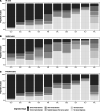Use of antipsychotics in Denmark 1997-2018: a nation-wide drug utilisation study with focus on off-label use and associated diagnoses
- PMID: 33820580
- PMCID: PMC8170176
- DOI: 10.1017/S2045796021000159
Use of antipsychotics in Denmark 1997-2018: a nation-wide drug utilisation study with focus on off-label use and associated diagnoses
Abstract
Aims: Antipsychotics are primarily labelled for the treatment of severe mental illness and have documented clinical utility in certain neurological disorders or palliative care. However, off-label use of antipsychotics is common and increasing, and prior studies on antipsychotic utilisation have not specifically assessed users in neurology, palliative care or general practice. We aimed to explore diagnoses associated with antipsychotic use, treatment patterns and characteristics of users without diagnoses relevant to antipsychotic treatment.
Methods: Population-based study identifiying all users of antipsychotics in Denmark (pop 5.7 mio.) 1997-2018 in the Danish National Prescription Register (DNPR). Possible indications for antipsychotic therapy were evaluated using in- and outpatient contacts from the DNPR. Users were divided hierarchically into six groups: severe mental disorders (schizophrenia, bipolar-spectrum disorders), chronic mental disorders (dementias, mental retardation, autism), other mental disorders (depression-spectrum, anxiety and personality disorders, etc.), selected neurological diseases, cancer and antipsychotic users without any of these diagnoses. This last group was characterised regarding demographics, antipsychotic use, health care utilisation and likely antipsychotic treatment initiator in 2018.
Results: Altogether, 630 307 antipsychotic users were identified, of whom 127 649 had filled prescriptions during 2018. Users without diagnoses relevant to antipsychotic treatment comprised of the largest group (37%), followed by schizophrenia and bipolar-spectrum disorders (34%), other mental disorders (15%), dementia, autism and mental retardation (11%), cancer (2.2%) and neurological diagnoses (2.0%). Of 37 478 incident users in 2018, 39% had no diagnosis relevant to antipsychotic treatment, 7.9% had major depression, 7.7% neurotic/stress-related disorders and 7.5% dementia. Quetiapine was most commonly used, both overall (51%) and among users without diagnoses relevant to antipsychotic treatment (58%). Of 14 474 incident users in 2018 without diagnoses relevant to antipsychotic treatment, treatment was most likely initiated by a general practitioner (65%), with only 17% seeing a psychiatrist during the following year. As many as 18% of patients with adjustment disorders and 14% of those without relevant diagnoses for antipsychotic use, remained on antipsychotic treatment 5 years after their first prescription.
Conclusions: Over one-third of antipsychotic users in Denmark did not have psychiatric, neurological or cancer diagnoses as possible indications for antipsychotic therapy. Many antipsychotics are initiated or prescribed in general practice, and a concerningly large subgroup without documented diagnoses relevant for antipsychotics continued to receive them. Rational prescribing, adequate side effect monitoring and further research into reasons for the observed antipsychotic use patterns and their risk-benefit ratio are needed.
Keywords: Antipsychotics; off-label; pharmacoepidemiology; quetiapine.
Conflict of interest statement
CUC has been a consultant and/or advisor to or have received honoraria from: Acadia, Alkermes, Allergan, Angelini, Axsome, Gedeon Richter, Gerson Lehrman Group, Indivior, IntraCellular Therapies, Janssen/J&J, Karuna, LB Pharma, Lundbeck, MedAvante-ProPhase, MedInCell, Medscape, Merck, Mylan, Neurocrine, Noven, Otsuka, Pfizer, Recordati, Rovi, Servier, Sumitomo Dainippon, Sunovion, Supernus, Takeda and Teva. He provided expert testimony for Janssen and Otsuka. He served on a Data Safety Monitoring Board for Lundbeck, Rovi, Supernus and Teva. He has received grant support from Janssen and Takeda. He is also a stock option holder of LB Pharma. MH, JHA, KA and JH have nothing to declare in relation to the current study.
Figures



References
-
- Andersen JS, Olivarius NDF and Krasnik A (2011) The Danish national health service register. Scandinavian Journal of Public Health 39(7 Suppl), 34–37. - PubMed
-
- Anderson SL and Vande Griend JP (2014) Quetiapine for insomnia: a review of the literature. American Journal of Health-System Pharmacy 71, 394–402. - PubMed
-
- Baandrup L and Kruse M (2016) Incident users of antipsychotics: who are they and how do they fare? Social Psychiatry and Psychiatric Epidemiology 51, 505–512. - PubMed
-
- Bendtsen L, Birk S, Kasch H, Aegidius K, Sørensen PS, Thomsen LL, Poulsen L, Rasmussen MJ, Kruuse C and Jensen R (2012) Reference programme: diagnosis and treatment of headache disorders and facial pain. Danish Headache Society, 2nd Edition. The Journal of Headache and Pain 13(Suppl 1), 1–29. - PMC - PubMed
MeSH terms
Substances
LinkOut - more resources
Full Text Sources
Other Literature Sources
Medical
Research Materials

